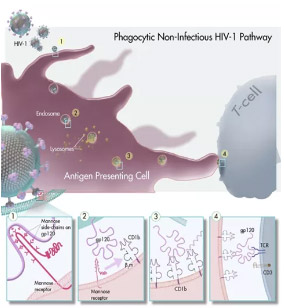Dr. Trujillo’s contributions to science have opened doors to the profound study of neurological diseases. He has worked in clinical and basic neuroscience research for over 25 years and has spent the last 10 years in translation research for brain regeneration technology. Dr. Trujillo has been on various scientific editorial boards and has published over 60 scientific manuscripts and reviews, and more than 50 conference abstracts and book chapters.
His most famous research includes antiviral immune responses in the nervous system, opportunistic AIDS infections, such as neurocysticercosis, and the molecular basis of neurotropism of HIV-1. He has also conducted cancer research and published articles on photodynamic therapy.
Dr. Trujillo’s paper on molecular mimicry between the human immunodeficiency virus type 1 gp120 V3 loop and human brain proteins was recognized as the scientific article of the year by Harvard University and by the American Society of Microbiology. He was the first medical scientist to identify a non-infectious sugar receptor MR for HIV-1 pathogenesis, an ingenious insight for viral vaccines, which was published in the Proceedings of the National Academy of Sciences.
Dr. Trujillo has been an intramural investigator at the National Institute of Neurological Disorders and Stroke at the NIH. He was also the Director of Latin American Research in Virology and Neurosciences and Head of the Laboratory of Neurovirology at the Institute of Human Virology, USA.
Selection of Publications
Long-Term Effectiveness of Photodynamic Therapy for CIN Treatment.
Inada NM, Buzzá HH, Leite MFM, Kurachi C, Trujillo JR, de Castro CA, Carbinatto FM, Lombardi W, Bagnato VS.
Pharmaceuticals (Basel). 2019 Jul 12;12(3):107. Doi: 10.3390/ph12030107

Photodynamic therapy
Light stimulates a photosensitizer to release toxic singlet oxygen which destroys targeted cancer cells.
Topical MAL-PDT for cervical intraepithelial neoplasia treatment: a non-surgical option to prevent a cervical cancer
Inada NM, Lombardi W, Cossetin N, Carbinatto FM, Trujillo JR , Kurachi C, Bagnato VS.
Photodiagnosis and Photodynamic Therapy 12(3):370. DOI:10.1016/j.pdpdt.2015.07.202
Photodynamic therapy: Progress toward a scientific and clinical network in Latin America
Buzzá HH, Silva APD, Vollet Filho JD, Ramirez DP, Trujillo JR, Inada NM, Moriyama LT, Kurachi C, Bagnato VS.
Photodiagnosis Photodyn Ther. 2016 Mar;13:261-266. doi: 10.1016/j.pdpdt.2015.08.004
Photodynamic therapy of cervical intraepithelial neoplasia
Inada NM, Lombardi W, Leite MFM, Trujillo JR, Kurachi C, Bagnato VS.
Proceedings of SPIE – The International Society for Optical Engineering 8931. DOI:10.1117/12.2040004. March 2014
Gliomas and brain lymphomas in HIV-1/AIDS patients: reflections from a 20-year follow up in Mexico and Brazil
Cedeno-Laurent F, Trujillo JR.
Microbiology Research June 2011; volume 3:e11 DOI:10.4081/mr.2011.e11
Human Polyomavirus-Associated Cerebral Disorders in the Post-HAART Era
Cedeno-Laurent F, Penalva de Oliveira AC, Vidal JE, Trujillo JR.
Patholog Res Int. 2011 Feb 22;2011:562427. doi: 10.4061/2011/562427
New insights into HIV-1-primary skin disorders
Cedeno-Laurent F, Gómez-Flores M, Mendez N, Ancer-Rodríguez J, Bryant JL, Gaspari AA, Trujillo JR.
J Int AIDS Soc. 2011 Jan 24;14:5. doi: 10.1186/1758-2652-14-5
The Mannose Receptor of Macrophages: The non-infectious pathway of HIV
Jileta Alida , Trujillo JR.
Rev Mex Neuroci. 2009; 10 (1):44-48.

Mannose Receptor
The glycoprotein spikes (yellow) on the surface of HIV are covered with sugars called mannose. If one of these sugars binds to a mannose receptor (red) on the surface of a macrophage, the immune cell will ingest the virus via phagocytosis. HIV will then be destroyed, and the cell will not be infected.
Inflammatory papillomatous hyperplasia and epidermal necrosis in a transgenic rat for HIV-1
Cedeno-Laurent F, Bryant J, Fishelevich R, Jones OD, Deng A, Eng ML, Gaspari AA, Trujillo JR.
J Dermatol Sci. 2009 Feb;53(2):112-9. doi: 10.1016/j.jdermsci.2008.08.015. Epub 2008 Nov 11.
Aids-related progressive multifocal leukoencephalopathy: a retrospective study in a referral center in São Paulo, Brazil
Vidal JE, Penalva de Oliveira AC, Fink MC, Pannuti CS, Trujillo JR.
Rev Inst Med Trop Sao Paulo. 2008 Jul-Aug;50(4):209-12. doi: 10.1590/s0036-46652008000400004.
Neurological Complications in Patients Co-infected with HIV-1 and Hepatitis C Virus
Cedeno-Laurent F, Berg E, Trujillo JR.
Rev Mex Neurosciences 2007; 8 (5): 512-515.
Noninfectious entry of HIV-1 into peripheral and brain macrophages mediated by the mannose receptor
Trujillo JR, Rogers R, Molina RM, Dangond F, McLane MF, Essex M, Brain JD.
Proc Natl Acad Sci U S A. 2007 Mar 20;104(12):5097-102. doi: 10.1073/pnas.0611263104. Epub 2007 Mar 14.

Model of noninfectious HIV-1 entry into antigen presenting cells.
The mannose-rich carbohydrates of gp120 initiate a noninfectious phagocytic pathway. This pathway links microbial antigen recognition by mannose receptors with presentation by CD1b, for the induction of cell-mediated immunity
BK virus associated meningoencephalitis in an AIDS patient treated with HAART
Vidal JE, Fink MC, Cedeno-Laurent F, Delbue S, Ferrante P, Dauar RF, Filho FB, Nogueira RS, Calore EE, Pannuti CS, Trujillo JR, de Oliveira AC.
AIDS Res Ther. 2007 Jun 8;4:13. doi: 10.1186/1742-6405-4-13.
Neurocysticercosis and HIV-1, 25 years of a co-infection follow-up
Cedeno-Laurent F, Ramírez-Rodríguez C, García-Ramos G, Martínez-Rodríguez HR, Ramos-Jiménez J, Ancer-Rodríguez J, Trujillo JR.
Neuroci. 2007;8(3):274-275.

Neurocysticercosis and HIV protection Co-infection of the central nervous system by opportunistic pathogens represents a common cause of consultation. Neurocysticercosis illustrates a parallel epidemic to that of AIDS. Epidemiological phenomenon suggests mutual protection between both infections.

